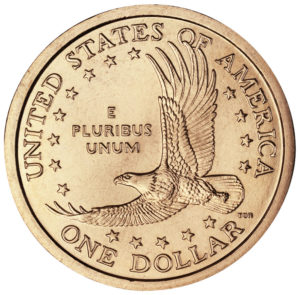
They land with a loud, dull clank in the change tray of the ticket vending machine. If you’re like me, your first thought as you scoop them out is, how do I get rid of them?
They’re the $1 coin. The unpopular, unloved and underutilized member of the coin family.
You’ll get them mostly from vending machines of one sort or another. And when you do, it becomes a monetary version of the old hot potato game. Who can I give them to next? Or, where’s another vending machine that will accept them?
I handed one to a clerk at a convenience store. The man did a double, then triple take, turning it over in his hand for a moment. He seemed to be trying to determine if it was a U.S. coin, and if it was, was it actually legit? It took him a few moments, but he accepted it.
I called Coin World magazine for some background on the $1 coin. Turns out the presidential dollar coin is no longer being made for circulation. That decision came back in 2011 by then Treasury Secretary Tim Geithner. The move to stop production came as part of an effort to cut government waste during the Great Recession. Since 2011, the $1 coins are produced just for collectors.
News articles at the time said the Federal Reserve had an excess of almost $1.4 billion of the $1 coins, thanks to people returning them. The inventory of the coins is decreasing, but just slightly from the 2011 level. Last year at this time the supply was about $1.2 billion.
And just how did the Fed wind up with so many $1 coins? Simple — more $1 coins were returned to the Fed than were paid out. So, you can see why shutting down production of the coins for circulation made sense.
“We simply shouldn’t be wasting taxpayer money on money that taxpayers aren’t using,” Geithner said at the time.
Seems logical, right? Why make money that people are simply not interested in using? But there are some parties that like the $1 coin, and a number of them have banded together to form the Dollar Coin Alliance.
The Alliance is made up of mass transit agencies, small businesses, trade associations and budget watchdogs. Budget watchdogs? Yes, and they make a pretty good point. The budget watchdogs like the $1 coin because by many estimates it could save American taxpayers billions of dollars.
Those billions would be realized by getting rid of the $1 paper bill, and switching to the $1 coin. Seems paper dollar bills wear out in about three years. Then they’re shredded and dumped in landfills. Just not an economical way to make money.
The dollar coins cost more to make, but they can last for three decades or more. And when they do wear out, they can be recycled.
The Alliance points to a poll showing 70% of voters favor replacing the dollar bill with the dollar coin, that is after they learn the switch could save the Federal government almost $14 billion over time.
The Alliance has other reasons for favoring so-called currency reform. It says businesses lose hundreds of millions of dollars in repairs and lost sales every year from jammed dollar bills in vending machines. Wait, that doesn’t happen, right? Heck, that alone may get people to switch to dollar coins.
Other countries have pulled it off and seen the savings. The Alliance points to Canada where the government realized significantly higher savings then estimated. And the group also points out that the United States has one of the smallest denominations of paper currency among the world’s major economies.
But it may take just flat out eliminating the $1 bill to get Americans to switch to a coin. Search the terms “$1 coin” and “unpopular” and you’ll see why. There’s no shortage of stories calling the coin unwanted, hated, and the red-headed stepchild of the currency family.
While the currency reform debate continues, technology is doing its part to change how we pay for things. Research and venture capital firm Loup Ventures says there were 127 million people worldwide using Apple Pay at the end of last year. That’s up from 62 million a year earlier.
It works out to be just about 16% of iPhone owners that have activated the payment system, and just 5% in the U.S. Loup is optimistic that Apple Pay will gain widespread adoption over the next three to five years.
So, while the paper versus coin debate continues for the dollar, more people will be choosing to pay with neither. Who needs to carry a worn out bill, or a big coin around when you can flash your phone and pay?